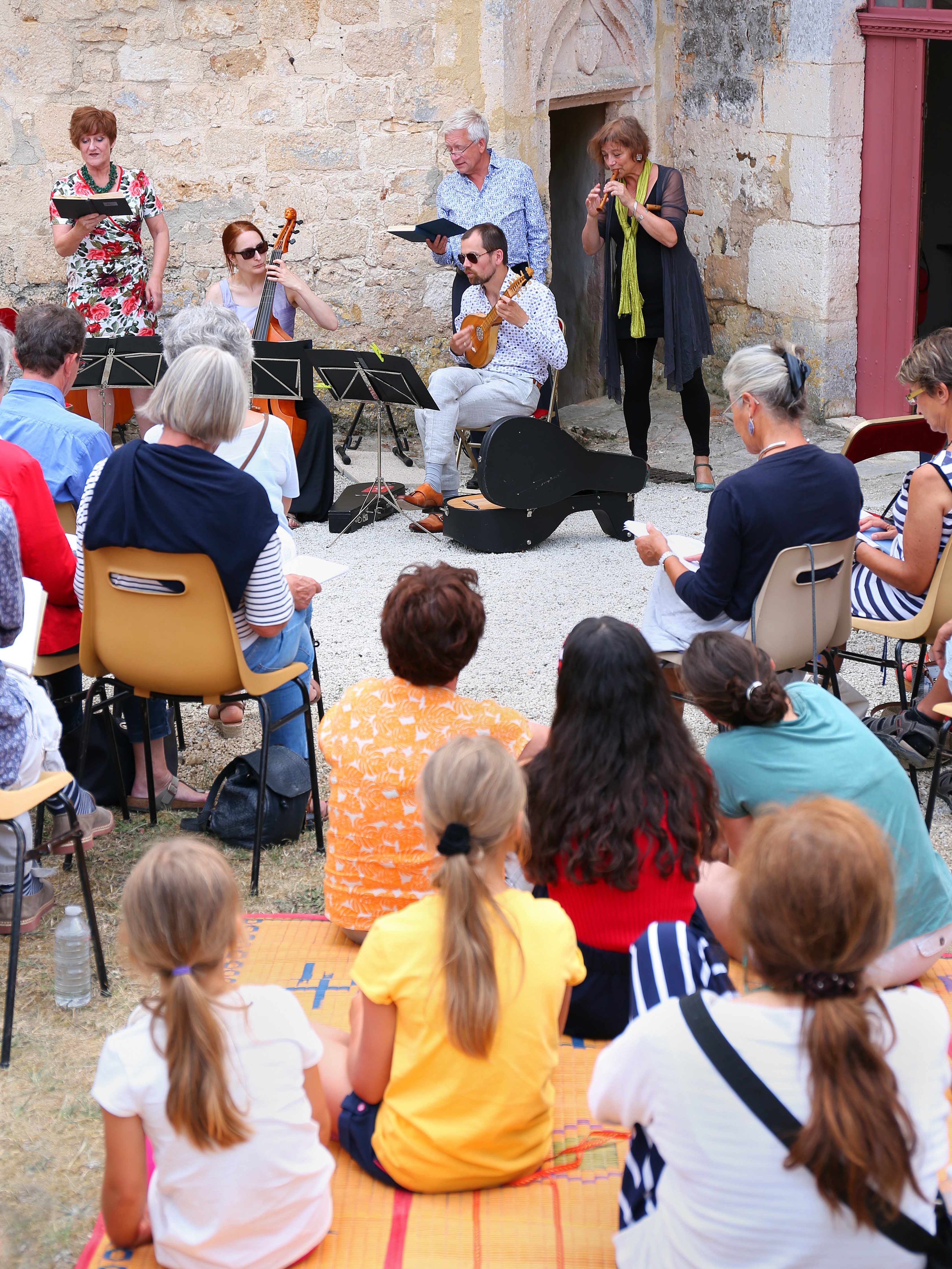Dordogne, France 26-29 July 2018
[dropcap]O[/dropcap]f many surprising features of the summer of 2018, few have excelled the strange experience of travelling from a parched, sun-scorched Britain basking in (or suffering from) an extreme heat-wave to the lush green of the equally sun-blessed woods and rolling hills of the Périgord vert, the most northern region of the Dordogne. It is there that the Itinéraire Baroque festival founded 17 summers ago by Ton Koopman takes place in the villages and hamlets of the area, invariably utilising the many Romanesque churches that adorn the Périgord vert.
The programme for my third visit to Itinéraire Baroque (my account of the 2016 festival can also be found on this site) had Spanish culture as an overarching theme, although no Spanish music featured in the opening concert on 26 July at the Romanesque (although much altered) abbey church of St Cybard in Cercles. Given by members of the Amsterdam Baroque Orchestra under Koopman, it did, however, adhere to what was virtually a subtext of the festival – music for exotic instruments or unusual instrumental combinations. Thus this concert included concertos by Telemann for oboe d’amore and two chalumeaux, by Gregor Werner (Haydn’s predecessor at Esterhazy) for two organs and two chalumeaux and a concerto for trombone by Albrechtsberger, the Classical style of which stood in stark contrast to the surrounding Baroque repertoire. In addition, the pleasingly light-voiced tenor Tilman Lichdi sang a folk-like strophic song of Werner and an undistinguished extract from one of his oratorios. Neither tested him to anything like the same extent as Bach’s Cantata No.55 ‘Ich armer Mensch’, where technical fallibilities were at times cruelly exposed. Nonetheless, the concert made for an enjoyable start to the festival, especially in the well-played Telemann concertos and Alessandro Marcello’s well-known Oboe Concerto in D minor.
St Cybard is very much ‘home base’ of the Festival, its delightful linden- shaded square filled during its course by ‘Café baroque’, where food, drink and stalls selling local bio produce are located. Such facilities proved much in demand at the lunchtime concert the following day, played by the chamber ensemble L’Astrée, who with soprano Julia Wischiewski gave a programme of Vivaldi trio sonatas and chamber cantatas. The instrumental part of the concert provided for me the most satisfying music making of the festival, with vital, well-articulated playing by violinist Paola Nervi and cellist Rebecca Ferri in quicker movements and truly eloquent playing in slower movements such as the exquisite Sarabanda of the Sonata in D minor, RV27, where the interplay between the two was totally engaging. I much liked, too, the tasteful ornamentation added to repeats. Despite some expressive singing and confident execution of passaggi, the cantatas were less satisfying. Wischiewski’s soprano was too often unevenly produced, her diction less than clear, while her ornamentation was often waywardly unstylish.
Following an afternoon devoted to a lecture on Spanish Baroque music and a concert devoted to music and dances in period costume from Spain and southern France – neither of which I attended – the evening concert found Koopman and his wife (and former pupil) Tini Mathot giving a recital for two organs and two harpsichords entitled ‘The Master and his Pupil’. Thus we heard music by, among others, J. S. Bach (the Prelude and Fugue in C, BWV 547, curiously played on harpsichords rather than organ) and W. F. Bach (a solo Concerto in F), Armand-Lous Couperin, who was taught by his father Nicholas, one of the great Couperin dynasty, and Antonio Soler, the most famous pupil of Alessandro Scarlatti. It was Soler who provided the meat of the programme, in quantity, if not substance, too much of his music being inconsequential, at times to a degree of banality. Both here and in organ works by Cabanilles and Perez de Albeniz the portative organs used by Mathot and Koopman were a monochrome substitute for the colourfully exotic sound of Spanish organs of the period.
The Saturday of the festival gives it its name and (to the best of my knowledge) unique feature, the day consisting of staggered visits to six venues, in most cases a small rural church of Romanesque origin. At each of these a short concert – preceded by a brief introduction to the building – is given by performers who remain in the same location for the day. It however started in the town church of Mareuil, where before being divided for the tour a large audience assembled to hear a selection of solo recorder music from Jacob van Eyck’s ‘Der fluyten lustof’ (well played by Reine-Marie Verhagen), music with which I confidently expect to be punished for all eternity should I end up in one of the circles of Dante’s Hell. Our first stop was the little church at Graulges, Romanesque at heart, but much restored. Judging from reaction I heard, the concert of 17th-century Italian and Dutch sonatas played by the gifted Ensemble Clematis was probably the most popular of the day. To me, however, it was a further depressing example of how young players still ignore the difference between all-purpose period instrument string playing and the special demands of 17th-century music. This applies especially to an ensemble like Clematis that specializes in this repertoire, when it can only be viewed as the lazy option that is to be deplored.

If this was a disappointment, the following event in the beautiful little chapel of St John the Baptist in the village of Puyrénier came as a pleasant surprise. Here Fred Jacobs, one of the doyens of the lute world, played a beguiling recital of works by Sor (mostly) and Giuliani on a Romantic guitar built in 1820. This is not repertoire I have explored in any depth, but here was struck by the sheer inventiveness of Sor in particular and the beauty of tone Jacobs produced throughout, especially in more contemplative pieces like the Cantabile, op 42/1.
Following a lunch break, the first of the afternoon concerts took as back to the outskirts of Mareuil and the church Saint Sulpice, where the Swiss ensemble Albori Musical played works by Vivaldi and Telemann and a sonata by Pierre Prowo formerly attributed to Telemann. Moderately accomplished playing failed to disguise the fact that the rhythmically four-square and often somewhat inexpressive performances rarely caught fire.

There was nothing inexpressive about the penultimate visit to the charming simplicity of the little church of Connezac, once the chapel of the eponymous chateau. Within its intimate surroundings the Austrian dulcimer player Franziska Fleischanderl illustrated with captivating charm its capabilities both in her playing and introductions. Particularly interesting was the great difference in sonority dependent on whether the instrument is plucked or struck with hammers, while the range of subtly modulated sound that can be cajoled from it in the hands of an obvious expert was strongly projected.

The final concert took place en plein air alongside the walls of the largely 15th-century Chateau D’Aucors. Given by Dutch group Camerata Trajectina, it introduced a programme based around the 16th-century struggle of the Netherlands to free itself from Spanish domination. Much more interesting historically than musically – it included a number of what we would today term protest songs – it was entertainingly projected by the experienced Heike Meppelink (soprano) and Nico van der Meel (tenor).
An early flight the following morning determined that I missed the final concert, a typical Koopman mix of Bach Orchestral Suites and Brandenburgs. But once again Itinéraire Baroque, with its loyal and enthusiastic audience playing a full part, had proved a captivating experience that can be enthusiastically recommended to anyone seeking an unusual musical holiday in one of the most beguiling parts of the Dordogne. https://www.itinerairebaroque.com/
Brian Robins


